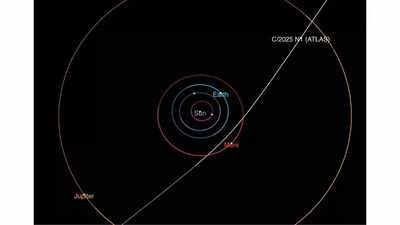
Astronomers have identified a fascinating new visitor to our solar system: an object believed to have originated from interstellar space. The object, officially named 3I/Atlas (C/2025 N1), was first observed on July 2, 2025, by the ATLAS survey telescope in Chile. This marks only the third confirmed interstellar object, following 'Oumuamua in 2017 and comet 2I/Borisov in 2019.
Currently, 3I/Atlas is traveling at a remarkable speed of 60 kilometers per second, located approximately 416 million miles from the Sun. Its trajectory suggests a hyperbolic orbit, reinforcing the theory that it originated outside of our solar system. NASA has confirmed that this interstellar traveler poses no threat to Earth.
The object, initially designated A11pl3Z, was discovered by the Asteroid Terrestrial-impact Last Alert System (ATLAS) in Chile. Subsequent observations by NASA and other institutions traced its path back to June 14, confirming its hyperbolic orbit and interstellar origins. As 3I/Atlas joins the short list of confirmed cosmic wanderers, it offers new evidence suggesting such objects may be more prevalent in the galaxy than previously thought. Currently, the object is approaching the inner solar system from the direction of the constellation Sagittarius.
Though initially classified as an asteroid, recent observations have revealed subtle signs of cometary activity. The Minor Planet Center has noted a faint coma and short tail, leading to its dual classification as C/2025 N1. Early brightness estimates suggested a size of around 20 kilometers in diameter. However, experts now believe that the dust cloud surrounding the object may be exaggerating its apparent size, and that the solid core is likely smaller. The object is expected to reach its closest point to the Sun around October 30, passing within the orbit of Mars.
Despite its extraordinary origins, NASA assures that 3I/Atlas will remain at a safe distance from Earth, never approaching closer than approximately 150 million miles. As it approaches the Sun, the object may brighten, potentially becoming visible through amateur telescopes in late 2025 and early 2026. The Virtual Telescope Project is planning a live broadcast for enthusiasts eager to witness this rare celestial event. Scientists hope that studying this object will provide valuable insights into the composition and behavior of interstellar bodies.
Newer articles
Older articles
 Daren Sammy Fined, Handed Demerit Point for Umpire Criticism After Test Match Comments
Daren Sammy Fined, Handed Demerit Point for Umpire Criticism After Test Match Comments
 Gavaskar Calls for Yadav's Inclusion, Questions Middle Order After India's Test Defeat
Gavaskar Calls for Yadav's Inclusion, Questions Middle Order After India's Test Defeat
 Decoding Your Health: Spotting 5 Prediabetes Warning Signs Before a Blood Test
Decoding Your Health: Spotting 5 Prediabetes Warning Signs Before a Blood Test
 X Corp. Cracks Down: Half a Million Indian Accounts Suspended for Policy Breaches
X Corp. Cracks Down: Half a Million Indian Accounts Suspended for Policy Breaches
 Headline:
Early Warning Signs: 5 Heart Attack Symptoms to Watch Out For Weeks in Advance
Headline:
Early Warning Signs: 5 Heart Attack Symptoms to Watch Out For Weeks in Advance
 Facial Icing: Benefits, Risks, and Safe Application of This Viral Beauty Trend
Facial Icing: Benefits, Risks, and Safe Application of This Viral Beauty Trend
 Chess Sensation Praggnanandhaa Joins Magnus Carlsen's Team Liquid for Esports World Cup
Chess Sensation Praggnanandhaa Joins Magnus Carlsen's Team Liquid for Esports World Cup
 Mastering JPG to PDF Conversion: A Graphic Designer's Guide to Quality and Efficiency
Mastering JPG to PDF Conversion: A Graphic Designer's Guide to Quality and Efficiency
 MI New York's Tajinder Dhillon Shines: From IPL Benchwarmer to MLC Star
MI New York's Tajinder Dhillon Shines: From IPL Benchwarmer to MLC Star
 Akmal Blasts PCB's Interim Coach Choice: Ex-Cricketer Questions Logic Behind Mahmood Appointment
Akmal Blasts PCB's Interim Coach Choice: Ex-Cricketer Questions Logic Behind Mahmood Appointment